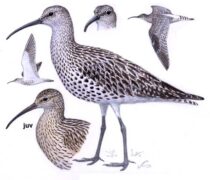In 1875 Bree wrote: “In all parts of Italy this species is met with; but while it is only a bird of passage and rather rare in the northern parts, in the central and southern parts it is common, and passes the winter there. In Sicily and in Malta it is the most common species […]
Category: Scolopacidae
Spoon-billed Sandpiper (Calidris pygmaea)
It is incredible what activity this little bird has rendered since, about 8 years ago, for still not fully understood reasons, its popluation had declined to less than a 1000 individuals. In present day it is estimated at only 250 individuals and the population is aging. The crucial countries all working together, the action plans, […]
How the Curlew Down-under got his thin red legs
Bleargah the hawk, mother of Ouyan the curlew, said one day to her son: “Go, Ouyan, out, take your spears and kill an emu. The women and I are hungry. You are a man, go out and kill, that we may eat. You must not stay always in the camp like an old woman; you […]
Folklore, how the Snipe got its long beak
At one time there were no lakes. There were creeks and rivers, but no lakes. Raven wanted to make lakes, so he made a depression in the ground for to collect the water and a new lake began to form. Then he put fish in the new lake. After a time he returned to see […]
Bird stories, Curlew (Numenius arquata)
The sad wailing, cry of these birds, while on the wing, in the dark still nights of winter, resembling the moans of wandering spirits, is believed in some parts of England to be a death warning, and called the cry of the Seven Whistlers. In Scotland the farmers think the cry is exactly like the […]
Subspecific Identification of the Willet Catoptrophorus semipalmatus
Willet (Catoptrophorus semipalmatus) Science Article 3 abstract The Willet is a familiar shorebird to many birders around temperate regions of North, Central, and South America. Its large size, drab plumage, and flashy wing pattern make it relatively straightforward to identify Michael O’Brien, BIRDING MAY/JUNE 2 0 0 6 Download article download full text (pdf)
Predator avoidance behaviour of a solitary Willet attacked by a Peregrine Falcon
Willet (Catoptrophorus semipalmatus) Science Article 2 abstract During the non-breeding season, Willets Catoptrophorus semipalmatus use a variety of tactics to avoid predators and have been reported to take flight, submerge themselves inwater, and hide in or near marsh vegetation JOSEPH B. BUCHANAN, Bulletin 104 August 2004 Download article download full text (pdf)
Social Organization In A Nesting Population Of Eastern Willets (Catoptrophorus Semipalmatus)
Willet (Catoptrophorus semipalmatus) Science Article 1 abstract The breeding ecology of eastern Willets (Catoptrophorus semipalmatus) was studied over a 3-yr period in a salt marsh on the Atlantic coast of Virginia. During the study,171 adults were color-marked MARSHALL A. HOWE, The Auk 99: 88-102. January 1982 Download article download full text (pdf)
Site Safety and Food Affect Movements of Semipalmated Sandpipers(Calidris pusilla) Migrating Through the Upper Bay of Fundy
Semipalmated Sandpiper (Calidris pusilla) Science Article 2 abstract The upper Bay of Fundy is a critical stopover site for Semipalmated Sandpipers (Calidrispusilla) during their fall migration. However, little is known about factors that influence selection of feeding and roosting sites by these birds, or the extent to which birds move between different sites during their […]
The structure of aerial displays in three species of calidridinae (scolopacidae)
Semipalmated Sandpiper (Calidris pusilla) Science Article 1 abstract Sandpipers in the subfamily Calidridinae (Scolopacidae) breed in the Arctic and Subarctic. In all species, unpaired males engage in distinctive aerial displays. Such displays are described for three species: Dunlin (Calidris alpina L.), Semipalmated Sandpiper (Calidris pusilla L.), and Stilt Sandpiper(Calidris himantopus Bonaparte). EDWARD H. MILLER, The […]


